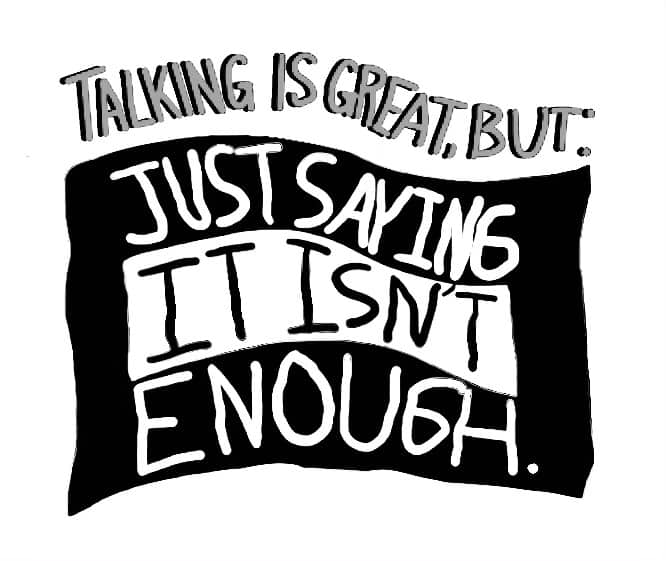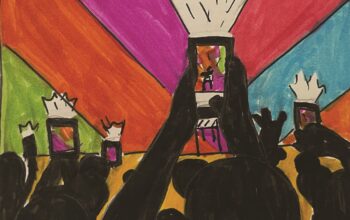
The Roosevelt 2021 Black Lives Matter (BLM) lessons took place over a series of weeks in February and March, in a structured and comprehensive format. The 13 guiding principles of BLM are central to the movement, and this year’s lessons worked to better understand these principles. Each lesson explored a new principle while building upon the previous one. Students participated in discussions, watched lectures and videos, and answered questions. The lessons were more engaging than in previous years and took a new approach to teaching.
David Grosskopf, a language arts teacher at Roosevelt, described the intention of these lessons as “shifts of perspective and heart, a broadening of who we care about and what that caring can be like.” Ultimately, the lessons were an important step towards making the RHS community into an anti-racist, empathetic, and caring one.
Overall, it’s clear that teachers and administrators worked hard to make these lessons organized and comprehensible, investing time to properly address each principle. But the lessons did have their shortcomings, the most prominent being how they appeared optional at times. Although each class was required to devote the entire allotted time to the lessons, it’s unclear whether all students actually participated. In most of my classes, only a few cameras are ever turned on. It’s difficult for teachers to monitor the progress and work of their students if they can’t see them and it’s similarly hard for students to engage with one another if we can’t see each other.
After each lesson, students were expected to complete and submit an online form, answering questions pertaining to the lesson. The questions were thoughtful and personal, and hopefully prompted meaningful and necessary thinking among students. However, because the questionnaires maintained the anonymity of the responders, teachers were unable to monitor individual student participation. Discussions were optional, lectures and videos didn’t require proof of participation, and questionnaires were anonymous. Therefore, participation wasn’t enforced.
Although these shortcomings may be the fault of the online format, it’s important to consider that most activities besides the BLM lessons in a classroom are compulsory, as they count for a grade. On the other hand, grading student participation might not be the right approach, as it turns the lessons into something that students are forced to do without allowing room to understand why they are important. Making sure students are engaging in the work is a challenge that will hopefully be tackled for lessons in future years.
To gain insight into other student’s perspectives, The Roosevelt News reached out to its followers via social media asking students to share what they enjoyed and did not enjoy about the lessons, and what could’ve been done better.
One common critique was the discomfort of being taught by a majority white staff. As a student of color, I too felt uncomfortable. My teachers are mostly white, so learning about BLM and racism was difficult because I felt like I was learning about these topics while experiencing the direct effects of structural racism.
Roosevelt’s student body is largely white, stemming from redlining, housing inequality, and other historically racist policies. The impression that these lessons cater to the white perspective of our school is something that I have felt for so long and is a sentiment that I think is shared by many other students of color.
Another common concern was that the lessons seemed performative. Instead of having two isolated week-long lessons on the subject, BLM and Black history should be incorporated into the yearly curriculum and daily learning. Subjects like history and social studies have a tendency to center the white perspective. The BLM lessons reflected a failure of regular class curriculums to actively incorporate the perspectives of Black people. White history is taught as being synonymous with history, while Black history is taught for two weeks a year, in specialized lessons in the name of BLM.
While setting aside time each year to specifically talk about Black history and BLM is a good start, integrating those subjects throughout the year into the curriculum and making space for the perspectives of Black people in all of the work we do at school would be a more long-term and ultimately more effective alternative.
General language arts classes, social studies classes, as well as most science and math classes, have a knack for centering the white perspective. With that said, Roosevelt’s Margins and Centers class, along with a few other courses, has broken the trend of ignoring marginalized voices by instead centering their voices. The points of view of all people are discussed and honored while the class works to actively embody the principles of BLM: diversity, empathy, collective value, globalism, and justice. In my twelve years of schooling, I have never seen a class that spends so much time practicing these core principles.
In order to make lasting change in the Roosevelt community, we need to incorporate BLM and its principles into all of our curricula, for which Margins and Centers is a great start. In addition, hiring and retaining teachers of color, redrawing boundary lines to diversify the school zone, and surveying people of color to determine the problems in our school are all examples of real action that would lead to change. It isn’t enough to tell students how to internalize the principles of BLM, but actually showing us how to live our lives utilizing these principles should be the aim of the lessons.
Despite all the room for improvement and growth, the BLM lessons this year were generally stronger than in the past. We learned more about the movement and its principles, and spent a lot more time responding to thoughtful questions, and participating in meaningful conversations. I was surprised and happy that we spent much more time this year on the lessons than in previous years, and am hoping that they will be even stronger in years to come.



